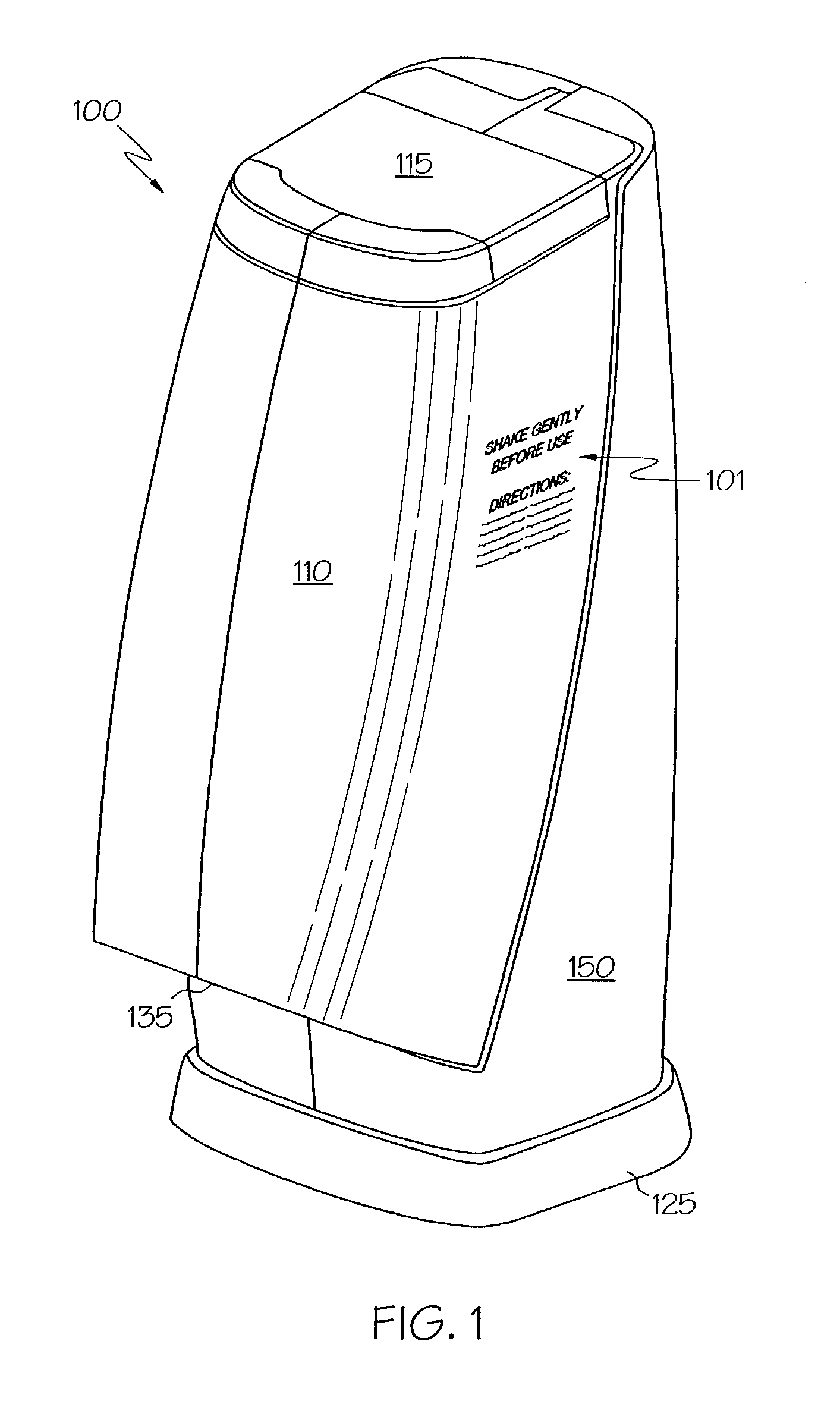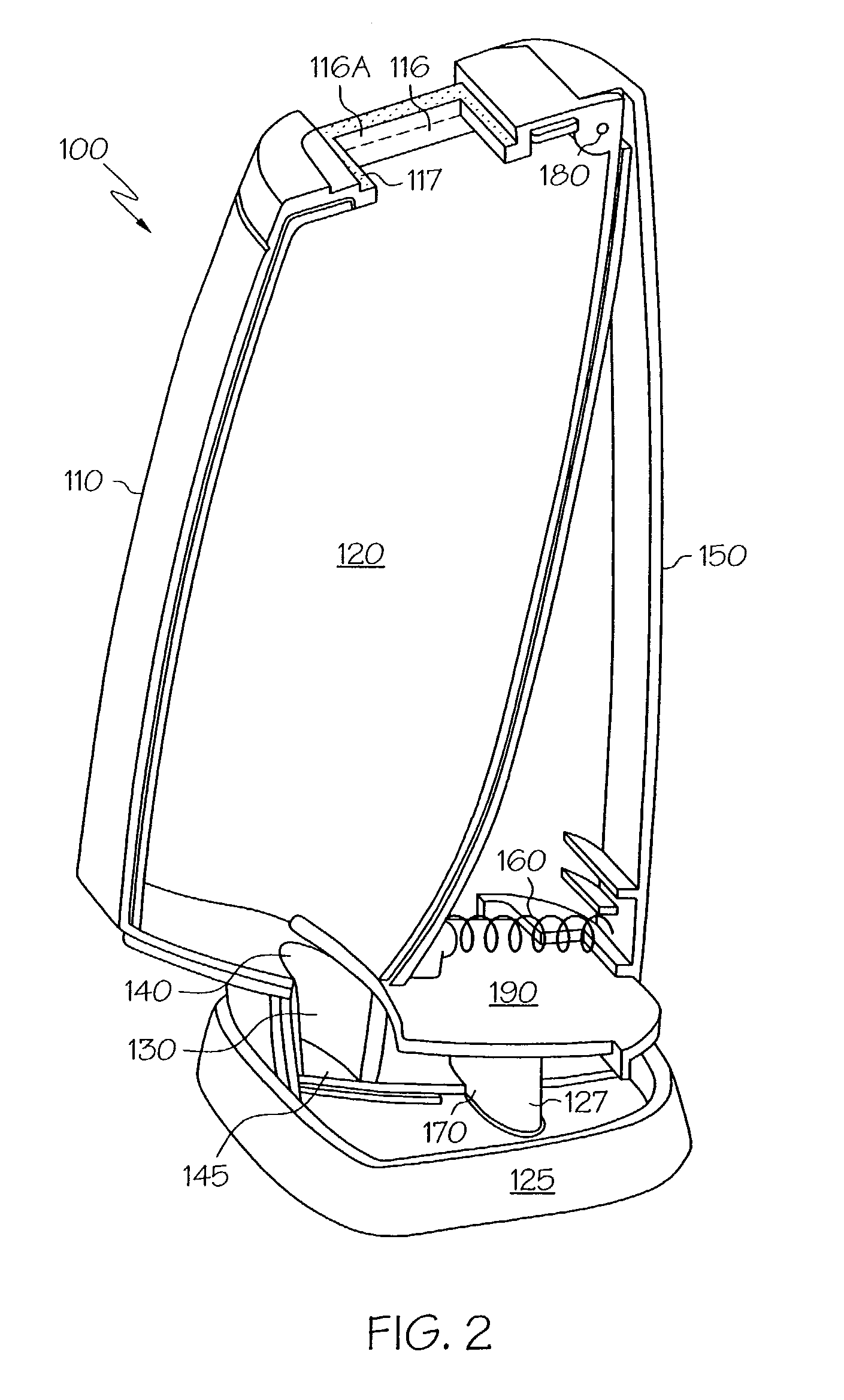[0010]The present invention satisfies these needs by integrating the fluent material to be dispensed with an inexpensive, simple-to-use device such that consistent, repeatable quantities of the fluent material can be dispensed by an untrained operator. By having the operator avoid all contact with the fluent material contents, the risk of
contamination to the contents is greatly reduced.
[0012]Optionally, the dispenser is of predominantly plastic construction. In the present context, the dispenser is “predominantly” plastic in that the bulk of the housing making up its structure is plastic, while it will recognized by those skilled in the art that discrete components, such as the biasing spring and pin making up the hinge, could be other materials, such as
metal. At least one portion may be of transparent plastic to facilitate
visual identification of the amount of fluent material remaining in the dispenser. For example, the reservoir may be made from a transparent plastic, and may further include one or more optical treatments, such as a
light filter, to inhibit
ultraviolet breakdown of the fluent material contents due to
exposure to
sunlight or the like. The
light filter can be made from, for example, a
low emissivity coating or colorations in the transparent plastic. Labels (for identification of the fluent material product contained within the dispenser) can be adhered to the dispenser, and may include viewing ports to achieve protection against the light while still providing
visual identification of the amount of fluent material remaining in the dispenser. For example, a vertically elongate
cut-out in the
label could allow a user to visually identify remaining product (thus making it readily apparent that it is time for the user to purchase more product), but block out a majority of the light. Similarly, the
label can include die
cut portions such that the user can selectively peel back the part of the
label circumscribed by the die
cut to be able to visually ascertain how much product remains. The sealing configuration of the disposable dispenser arises out of a connection between a cover through which the fluent material may be added to the reservoir and a fill aperture located in the reservoir.
[0015]In another option, the reservoir and actuation mechanism together form a single housing such that the two halves are of relatively
equal size, shape and volume. In this configuration, the dispenser may further include a pair of cutoff members for the storage compartment, one extending from the reservoir and the other extending from the actuation mechanism such that they can overlap one another. Preferably, the apertures in the two cutoff members substantially align while the dispenser is in its first actuation position so that the fluent material from the storage compartment can pass through the flowpath formed by the aligned apertures and into to the
discharge compartment. When the dispenser is in the second actuation position, the storage compartment
discharge apertures are substantially misaligned such that flow of the fluent material from the storage compartment to the discharge compartment is impeded. In addition, the dispenser may further comprise cutoff members in the discharge compartment that are configured similar to those of the storage compartment mentioned above, such that the discharge compartment cutoff members are configured to overlap one another at least during one of the first or second actuation positions. Selectively aligned / misaligned apertures in each of the discharge compartment cutoff members function to either allow or impede fluent
material flow out of the discharge compartment.
[0019]The integrated dispenser has numerous
consumer benefits. For example, the material and the dispenser are provided in tandem, thus there is no need for the
consumer to fill or otherwise transfer material to the dispenser. The dispenser is sealed to protect against
contamination and to extend the shelf-life of the fluent material. The dispenser also, through a closure
detent on the mounting base, has a safety lock to prevent accidental discharge of the fluent material contents, allowing the dispenser to be free standing. The size and ergonomic features of the dispenser allow it to be used with one hand, thus facilitating use by individuals with otherwise
limited capacity to dispense a predetermined quantity of fluent material product. Other features, such as a “time to buy” view hole, tracking information and ingredient labeling and required information add to its utility. The dispenser can provide appropriate dosages within very close tolerances, and the dispensing procedures are similar for all materials by use within a particular animal or human category. The integrated dispenser also has numerous benefits to the retail trade, such as consistent packaging
by product category, uniqueness, easy to explain use directions and breadth of product line.
 Login to View More
Login to View More  Login to View More
Login to View More 


